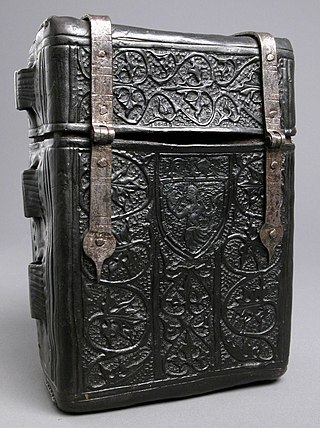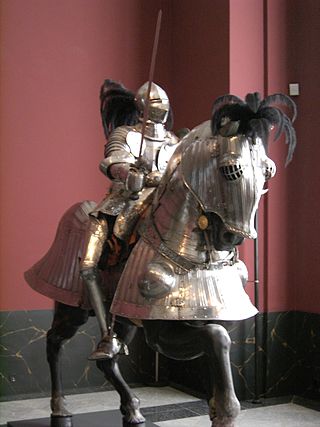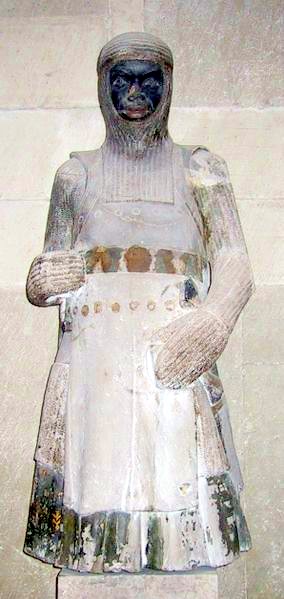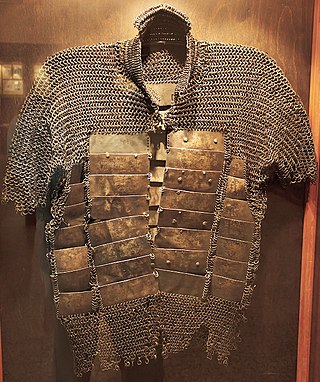Related Research Articles

Armour or armor is a covering used to protect an object, individual, or vehicle from physical injury or damage, especially direct contact weapons or projectiles during combat, or from a potentially dangerous environment or activity. Personal armour is used to protect soldiers and war animals. Vehicle armour is used on warships, armoured fighting vehicles, and some combat aircraft, mostly ground attack aircraft.

Boiled leather, often referred to by its French translation, cuir bouilli, was a historical material common in the Middle Ages and Early Modern Period and used for various purposes. It was leather that had been treated so that it became tough and rigid, as well as able to hold moulded decoration. It was the usual material for the robust carrying-cases that were made for important pieces of metalwork, instruments such as astrolabes, personal sets of cutlery, books, pens and the like. It was used for some armour, being both much cheaper and much lighter than plate armour, but could not withstand a direct blow from a blade, nor a gunshot.

Chain mail is a type of Armour consisting of small metal rings linked together in a pattern to form a mesh. It was in common military use between the 3rd century BC and the and 16th century AD in Europe, while continued to be used in Asia, Africa, and the Middle East as late as the 17th century. A coat of this Armour is often called a hauberk or sometimes a byrnie.

A cuirass is a piece of armour that covers the torso, formed of one or more pieces of metal or other rigid material. The word probably originates from the original material, leather, from the French cuirace and Latin word coriacea. The use of the term "cuirass" generally refers to both the breastplate and the backplate pieces; whereas a breastplate only protects the front, a cuirass protects both the front and the back of the wearer.

Lamellar armour is a type of body armour, made from small rectangular plates of iron or steel, leather (rawhide), bone, or bronze laced into horizontal rows. Lamellar armour was used over a wide range of time periods in Central Asia, Eastern Asia, Western Asia, and Eastern Europe. The earliest evidence for lamellar armour comes from sculpted artwork of the Neo-Assyrian Empire in the Near East.

A brigandine is a form of body armour from the Middle Ages. It is a garment typically made of heavy cloth, canvas, or leather, lined internally with small oblong steel plates riveted to the fabric, sometimes with a second layer of fabric on the inside.

Scale armour is an early form of armour consisting of many individual small armour scales (plates) of various shapes attached to each other and to a backing of cloth or leather in overlapping rows. Scale armour was worn by warriors of many different cultures as well as their horses. The material used to make the scales varied and included bronze, iron, steel, rawhide, leather, cuir bouilli, seeds, horn, or pangolin scales. The variations are primarily the result of material availability.

Barding is body armour for war horses. The practice of armoring horses was first extensively developed in antiquity in the eastern kingdoms of Parthia and Pahlava. After the conquests of Alexander the Great it likely made its way into European military practices via the Seleucid Empire and later Byzantine Empire. Though its historical roots lie in antiquity in the regions of what was once the Persian Empire, barded horses have become a symbol of the late European Middle Ages chivalry and the era of knights.

Ring armour is an assumed type of personal armour constructed as series of metallic rings sewn to a fabric or leather foundation. No actual examples of this type of armour are known from collections or archaeological excavations in Europe. It is sometimes called ringmail or ring mail. In the Victorian era the term "mail" was used fancifully for any form of metallic body armour. Modern historians reserve the term "mail" for armour formed of an interlinked mesh of metal rings.

Sangu is the term for the three armour components that protected the extremities of the samurai class of feudal Japan.

Auxiliary armour in a set of Japanese armour are optional pieces worn by the samurai class of feudal Japan in addition to the traditional six armour components.

Splint armour is armour consisting of strips of metal ("splints") attached to a cloth or leather backing. It is most commonly found as limb armour such as greaves or vambraces.

A coat of plates is a form of segmented torso armour consisting of overlapping metal plates riveted inside a cloth or leather garment. The coat of plates is considered part of the era of transitional armour and was normally worn as part of a full knightly harness. The coat saw its introduction in Europe among the warring elite in the 1180s or 1220s and was well established by the 1250s. It was in very common usage by the 1290s. By the 1350s it was universal among infantry militias as well. After about 1340, the plates covering the chest were combined to form an early breastplate, replacing the coat of plates. After 1370, the breastplate covered the entire torso. Different forms of the coat of plates, known as the brigandine and jack of plates, remained in use until the late 16th century.

Mail and plate armour is a type of mail with embedded plates. Armour of this type has been used in the Middle East, North Africa, Ottoman Empire, Japan, China, Korea, Vietnam, Central Asia, Greater Iran, India, Eastern Europe, and Nusantara.

Transitional armour describes the armour used in Europe around the 14th century, as body armour moved from simple mail hauberks to full plate armour.

Scholars agree that Japanese armour first appeared in the 4th century, with the discovery of the cuirass and basic helmets in graves. During the Heian period (794-1185), the unique Japanese samurai armour ō-yoroi and dō-maru appeared. The Japanese cuirass evolved into the more familiar style of body armour worn by the samurai known as the dou or dō, with the use of leather straps (nerigawa), and lacquer for weatherproofing. Leather and/or iron scales were also used to construct samurai armours, with leather and eventually silk lace used to connect the individual scales (kozane) of these cuirasses.

Kikko are small iron or hardened leather, hexagon shaped armour plates used in the construction of Japanese armor worn by samurai and ashigaru of feudal Japan.

Laminar armour is an armour made from horizontal overlapping rows or bands of, usually small, solid armour plates called lames, as opposed to lamellar armour, which is made from individual armour scales laced together to form a solid-looking strip of armour. Prominent examples of such armour are lorica segmentata of Ancient Rome and certain versions of samurai armour.

Tatami (畳具足), or tatami gusoku, was a type of lightweight portable folding Japanese armour worn during the feudal era of Japan by the samurai class and their foot soldiers (ashigaru). The Tatami dō or the tatami katabira were the main components of a full suit of tatami armour.

Dō or dou (胴) "breastplate, cuirass" is one of the major components of Japanese armour worn by the samurai and ashigaru or foot soldiers of feudal Japan.
References
- http://de.academic.ru/pictures/dewiki/65/Arten_von_Panzerhemden.jpg
- https://web.archive.org/web/20120425232355/http://www.fantasy-workshop.com/faw/image-files/banded-mail-4.jpg
- http://de.academic.ru/pictures/dewiki/87/Wartburg-Ludwig_der_Eiserne.jpg